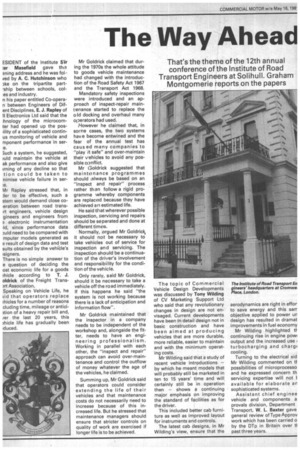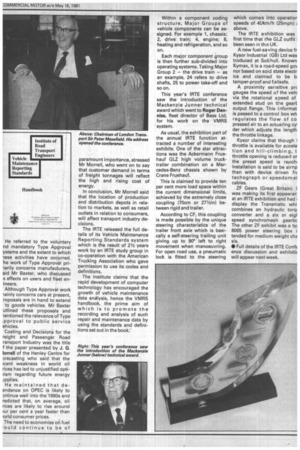The Way Ahead
Page 32

Page 33

If you've noticed an error in this article please click here to report it so we can fix it.
That's the theme of the 12th annual conference of the Institute of Road Transport Engineers at Solihull. Graham Montgomerie reports on the papers
ESIDENT of the Institute Sir :er Masefield gave thca 9ning address and he was fol.'red by A. C. Hutchinson who )ke on the tripartite part'ship between schools, coles and industry.
n his paper entitled Co-operan between Engineers of Difent Disciplines, E. J. Rapley of II Electronics Ltd said that the hnology of the microcomter had opened up the pos,ility of a sophisticated continus monitoring of vehicle and mponent performance in sere.
such a system, he suggested, )uld maintain the vehicle at ak performance and also give 'ming of any decline so that tion could be taken to nimise vehicle failure in ser:e.
Mr Rapley stressed that, in Jer to be effective, such a stem would demand close coeration between road trans41 engineers, vehicle design gineers and engineers from a electronic instrumentation Id, since performance data )uld need to be compared with mputer models generated as e result of design data and test suits obtained by the vehicle's :signers.
There is no simple answer to e question of deciding the ost economic life for a goods 3hicle according to T. J. oldrick of the Freight Trans)rt Association.
Speaking on Vehicle Life, he iid that operators replace hicles for a number of reasons eluding time, mileage or antici)tion of a heavy repair bill and, rer the last 20 years, this ;hide life has gradually been .cluced. Mr Goldrick claimed that during the 1970s the whole attitude to goods vehicle maintenance had changed with the introduction of the Road Safety Act 1967 and the Transport Act 1968.
Mandatory safety inspections were introduced and an approach of inspect-repair maintenance started to replace the old docking and overhaul many operators had used.
,However he claimed that, in some cases, the two systems have become entwined and the fear of the annual test has caused many companies to "play it safe" and over-maintain their vehicles to avoid any possible conflict.
Mr Goldrick suggested that maintenance programmes should always be based on an "inspect and repair" process rather than follow a rigid programme vvhereby components are replaced because they have achieved an estimated life.
He said that wherever possible inspection, servicing and repairs should be separated and done at different times.
Normally, argued Mr Goldrick, it should not be necessary to take vehicles out of service for inspection and servicing. The inspection should be a continuation of the driver's involvement and responsibility for the condition of the vehicle.
Only rarely, said Mr Goldrick, should it be necessary to take a vehicle off the road immediately. If this happens he said "the system is not working because there is a lack of anticipation and information flow".
Mr Goldrick maintained that the inspector in a company needs to be independent of the workshop and, alongside the fitter, needs to have an engineering professionalism. Working in parallel with each other, the "inspect and repair" approach can avoid over-maintenance and control the outflow of money whatever the age of the vehicles, he claimed.
Summing up, Mr Goldrick said that operators could consider extending the life of their vehicles and that maintenance costs do not necessarily need to increase because of this increased life. But he stressed that maintenance managers should ensure that stricter controls on quality of work are exercised if longer life is to be achieved. The topic of Commercial Vehicle Design Developments was discussed by Tony Wilding of CV Marketing Support Ltd who said that any revolutionary changes in design are not envisaged. Current developments have been in detail design not in basic construction and have been aimed at producing vehicles that are more durable, more reliable, easier to maintain and with the minimum operating costs.
Mr Wilding said that a study of recent vehicle introductions — by which he meant models that will probably still be marketed in ten to 15 years' time and will certainly still be in operation then — shows a continuing major emphasis on improving the standard of facilities as for the driver.
This included better cab furniture as well as improved layout for instruments and controls.
The latest cab designs, in Mr Wilding's view, ensure that the aerodynamics are right in effor to save energy and this sarr objective applied to power ur design has resulted in dramat improvements in fuel economy
Mr Wilding highlighted tlcontinuing rise in engine pow' output and the increased use turbocharging and chargt cooling.
Turning to the electrical sid Mr Wilding commented on tt possibilities of microprocesso and he expressed concern th servicing expertise will not t available for elaborate ac sophisticated systems.
Assistant chief enginee vehicle and components a provals division, Department Transport, W. L. Baxter gave general review of Type Approv work which has been carried o by the DTp in Britain over II past three years. He referred to the voluntary nd mandatory Type Approval ystems and the extent to which iese activities have occurred. 'he work of Type Approval prilarily concerns manufacturers, aid Mr Baxter, who discussed s effects on users and fleet enineers.
Although Type Approval work -iainly concerns cars at present, roposals are in hand to extend
to goods vehicles. Mr Baxter utlined these proposals and ientioned the relevance of Type ,pproval to public service ehicles.
Costing and Decisions for the reight and Passenger Road ransport Industry was the title f the paper presented by J. G. lorrell of the Henley Centre for 3 recasting who said that the icent weakness in world oil rices has led to unjustified optiiism regarding future energy ipplies.
He maintained that deendence on OPEC is likely to Dntinue well into the 1990s and redicted that, on average, oil rices are likely to rise around )ur per cent a year faster than .orld consumer prices.
The need to economise on fuel 'ould continue to be of paramount importance, stressed Mr Morrell, who went on to say that customer demand in terms of freight tonnages will reflect the high and rising cost of energy.
In conclusion, Mr Morrell said that the location of production and distribution depots in relation to markets, as well as retail outlets in relation to consumers, will affect transport industry decisions.
The IRTE released the full details of its Vehicle Maintenance Reporting Standards system which is the result of 21/2 years work by an IRTE study group in co-operation with the American Trucking Association who gave
permission to use its codes and definitions.
The Institute claims that the rapid development of computer technology has encouraged the growth of vehicle maintenance data analysis, hence the VMRS handbook, the prime aim of which is to promote the recording and analysis of such repair and maintenance data by using the standards and definitions set out in the book.
Within a component coding structure, Major Groups of vehicle components can be assigned. For example 1, chassis; 2, drive train; 4, engine; 8, heating and refrigeration, and so on.
Each major component group is then further sub-divided into operating systems. Taking Major Group 2 — the drive train — as an example, 24 refers to drive shafts, 25 to power take-off and so on.
This year's IRTE conference saw the introduction of the Mackenzie Junner technical award which went to Roger Denniss, fleet director of Bass Ltd, for his work on the VMRS system.
As usual, the exhibition part of the annual IRTE function attracted a number of interesting exhibits. One of the star attractions was the Ackermann Fruehauf GLZ high volume trucktrailer combination on a Mercedes-Benz chassis shown by Crane Fruehauf.
This is claimed to provide ten per cent more load space within the current dimensional limits, achieved by the extremely close coupling (70cm or 271/2in) between rigid and trailer.
According to CF, this coupling is made possible by the unique steering characteristics of the trailer front axle which is basically a self-steering trailing unit giving up to 90° left to right movement when manoeuvring. For open road use, a pneumatic lock is fitted to the steering which comes into operatior speeds of 40km/h (25mph) ; above.
The IRTE exhibition was first time that the GLZ outfit been seen in the UK.
A new fuel-saving device fr Kysor Industrial (GB) Ltd was traduced at Soli hull. Known Kymax, it is a road-speed go\ nor based on sold state electr ics and claimed to be b tamper-proof and f,ailsafe.
A proximity sensitive prc gauges the speed of the vehi via the rotational speed of extended stud on the geart output flange. This informat is passed to a control box wh regulates the flow of co pressed air to an actual'ing cyl der which adjusts the length the throttle linkage.
Kysor claims that though I throttle is available for accele tion and hill-climbing, t throttle opening is reduced or the preset speed is reach! Installation is said to be sirrip than with device driven frc tachograph or speedom ei cables.
ZF Gears (Great Britain) was making its first appearar at an IRTE exhibition and had display the Transmatic whi combines an hydraulic taro' converter and a six or eigf speed synchromesh gearbc The other ZF exhibit was a tyl 8065 power steering box i tended for medium weight cha sis.
0 Full details of the IRTE ConfE ence discussion and exhibitic will appear next week.




































































































































